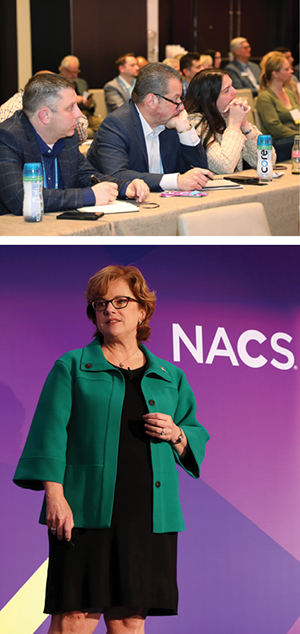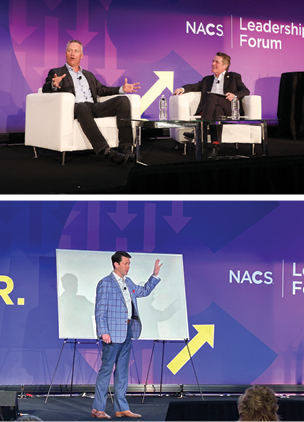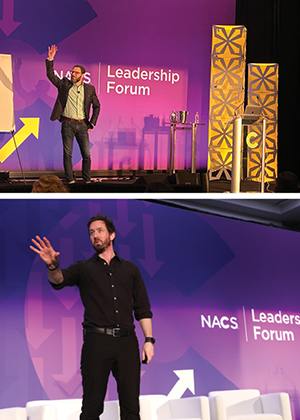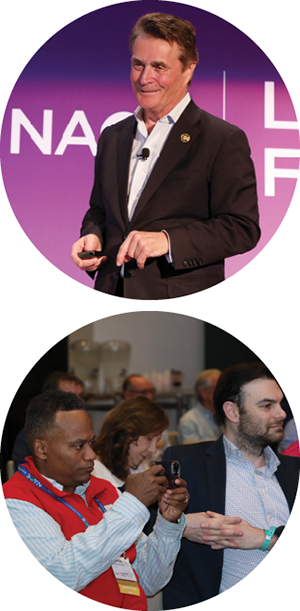 Top: The Leadership Forum featured general sessions and panel discussions on the theme of innovation.
Top: The Leadership Forum featured general sessions and panel discussions on the theme of innovation.
Bottom: Lori Buss Stillman, NACS vice president, research and education.
Image Caption above: L to R: Thomas Trkla, president and CEO, Yesway; Mark Romaine, COO, Global Partners LP; Mark Jordan, president and CEO, Refuel Inc.; and Bob Orr, partner and North America Head Energy Practice, Oliver Wyman, during the Going All In on Growth Retail Panel discussion.
The NACS Leadership Forum is an exclusive event bringing together top executives of industry-leading companies to discuss and explore how to lead in today’s hyper-convenience-focused world. Over three days in Miami Beach, Florida, in February, invited convenience retailers connected with industry peers and took inspiration from each other and the insights delivered by the keynote speakers and session panelists.
The event opened with a general session featuring Casey’s President and CEO Darren Rebelez, who sat down with NACS President and CEO Henry Armour to discuss how the Iowa-based retailer continues to innovate the guest experience and its iconic pizza program. Casey’s, with more than 2,400 stores in 16 states, is the third-largest convenience retailer in the United States and the fifth-largest pizza chain.
Since taking the helm in 2019, Rebelez has led the 55-year-old company on a transformation to “be a bigger, better and more contemporary version of ourselves,” he said. Guided by a new strategic plan, Casey’s has refreshed its brand, launched private-label goods, made significant new acquisitions and added new digital capabilities across loyalty, delivery and fulfillment.
We have a whole team that is dedicated to simplifying everything we do in the stores, and we’ve taken a lot of things off of the store managers’ plates, or off our team members’ plates, just to make the job easier.”
—Darren Rebelez, Casey’s President and CEO
The plan centers on four primary strategies: reinventing the guest experience, identifying operational efficiencies, accelerating store growth and investing in people and community. When it comes to the guest experience, Casey’s starts with merchandising and product assortment. An important part of this is Casey’s digital platform and rewards program, which now has six million members. Rebelez shared that 64% of Casey’s rewards members engage with the brand during a 90-day period. On a monthly basis, 50% of loyalty members engage with the brand, beating industry averages for engagement.
And then, of course, there is Casey’s pizza program, which Rebelez calls the “crown jewels” of the operation. “There’s a lot of love put into that pizza,” Rebelez said, noting that everything is made from scratch with fresh ingredients on-site each day.
The foodservice team has worked to elevate the rest of the menu to the “Casey’s good” level of its beloved pizza, in part by simplifying kitchen operations. And the culinary team isn’t done creating new pizza flavors. “Last summer our team identified that brisket was on trend, and so we launched a new BBQ Brisket Pizza, which is phenomenal,” Rebelez said. The pizza was so good that it earned a spot on the permanent menu and became Casey’s best-selling LTO to date.
A lack of engagement is a result of a lack of inspiration.”
—Kevin Paul Scott, co-founder of ADDO Worldwide
To celebrate the 21st birthday of its famous breakfast pizza in September 2022, Casey’s collaborated with Anheuser-Busch on an LTO dubbed the Ultimate Beer Cheese Breakfast Pizza, complete with Busch Light beer cheese sauce. “We rolled that out, and it immediately took off,” Rebelez said, “but really what was great about that, in addition to selling a lot, it was a huge thing on social media. We generated over 80 million impressions on social media just over this one pizza.”
Rebelez shared how Casey’s is working to simplify processes at the store level based on feedback from store employees, who noted that they increasingly were taking on more responsibilities without giving up tasks. “We have a whole team that is dedicated to simplifying everything we do in the stores, and we’ve taken a lot of things off of the store managers’ plates, or off our team members’ plates, just to make the job easier,” Rebelez said. The effort to remove complexity is paying off so far in reduced store-level turnover and improved guest satisfaction.
Transformation doesn’t happen in one fell swoop. It happens with a series of small steps that eventually ladder up.”
—David Schonthal, professor of strategy, innovation and entrepreneurship at Kellogg School of Management
3 KEYS TO INSPIRATION
Every organization grapples with how to effectively engage teams and keep them engaged to drive customer loyalty and improve business results. The question is, how to get there? Today’s workforce is feeling less inspired than ever before, and that’s true from the rank and file to the c-suite, research from Gallup indicates. “The current disengagement rate of the American workforce is at 79%,” Kevin Paul Scott, co-founder of ADDO Worldwide, shared.
Within that group, 18% or 19% of the workforce is actively disengaged, he pointed out, which Gallup defines as “disgruntled and disloyal.” Only 21% of employees are engaged with their work. Why have people checked out mentally on the job? “The top three reasons people cite are, ‘They don’t have a connection to the mission or purpose,’” Scott said. “‘They don’t have opportunities to learn and grow,’ and ‘they don’t feel cared for’” at work.
 Top: L to R: Darren Rebelez, Casey’s president and CEO, and Henry Armour, NACS president and CEO.
Top: L to R: Darren Rebelez, Casey’s president and CEO, and Henry Armour, NACS president and CEO.
Bottom: Kevin Paul Scott, co-founder of ADDO Worldwide
“A lack of engagement is a result of a lack of inspiration,” he said. “Inspiration happens when there are a certain group of elements that exist at the same time, and they must be present in order for people to be inspired.” In a Harvard Business Review study of 50,000 leaders, “the No. 1 quality people look for in their leader is someone who is inspiring,” Scott said. These are what he describes as the three essential, indispensable ingredients for inspiration: purpose, problem (to be solved) and partners.
Companies need to clearly define their purpose and make sure every employee knows it. “When you think about purpose, there are three things you need to do,” Scott said. “You’ve got to define it. You’ve got to revisit it often. You’ve got to connect their activities to it,” he said. “When the purpose is clear, the mundane becomes meaningful.”
Still, purpose alone isn’t enough. “For someone to be inspired, they not only have to have a purpose they’re shooting for. They’ve got to have a problem or a challenge or obstacles— something that’s worth doing to overcome,” Scott said. Boredom ensues when things are too easy to solve, he said. Effort is where learning and fulfillment come in. Then it’s important to have people to partner with you on the journey.
 Top: Networking between sessions at the Leadership Forum.
Top: Networking between sessions at the Leadership Forum.
Center: Thomas Trkla, chairman and CEO, Yesway Inc.
Bottom: L to R: Derek Gaskins, chief marketing officer, Yesway; Don Rhoads, 2022-23 NACS chair and
president and CEO of The Convenience Group LLC; Katie Bohny, NACS director, NACSPAC; and Lisa Dell’Alba, president and CEO of Square One Markets Inc.
“If you are totally isolated and alone, it doesn’t matter if you have a purpose and if you have problems to solve. Eventually you will lose the inspiration because you don’t have somebody in it to share things with,” Scott said.
OVERCOME RESISTANCE TO NEW IDEAS
David Schonthal, professor of strategy, innovation and entrepreneurship at Kellogg School of Management, shared insights on the four frictions that operate against innovation: inertia, effort, reactance and emotion.
When it comes to getting people to say yes to a new idea or innovation, too often corporate leadership focuses on the appeal of the innovation instead of anticipating the reasons why employees might resist their ideas and initiatives and then helping them see the bigger picture.
“Sometimes the job of the innovator isn’t to feature all of the new benefits that they are bringing to market, it is to make any new idea feel familiar to their audience,” Schonthal said. In the design world, it’s called meeting people where they are.
“There are two forces at play anytime we are attempting to do something new,” Schonthal said. Fuel and friction. “As human beings we tend to think in fuel,” he said. “Removing friction is often more powerful than increasing fuel.”
He offered the example of consumers who are motivated to buy a new sofa but resist because they don’t know what to do with their old one. Enter a furniture company whose marketing focused on the feeling of upgrading a home’s environment—and removing the old furniture—not just selling consumers a new sofa.
“Remove friction just enough to make it easy for people to say yes,” Schonthal said.
How do you get people within your organization, especially those who may have been on the job for decades, to buy into ideas that will change the way they work? Rather than announce a big transformation project, practice a design principle called “starting small,” Schonthal advised.
 Top: David Schonthal, professor of strategy, innovation and entrepreneurship at Kellogg School of Management
Top: David Schonthal, professor of strategy, innovation and entrepreneurship at Kellogg School of Management
Bottom:Henry Armour, NACS president and CEO
As a first step, consider a beacon project where a group of employees volunteers to focus on one small aspect of a larger problem and tackle it in a new way within a short time frame. Then they share their learnings with other departments. “Here’s how we accomplished what we did. Here’s how we would have done it the old way, and here’s how we did it the new way,” he said, citing a real-world example of a digital transformation project undertaken by the California state government. “By signaling with a beacon project how things can be done differently, they’re creating transformational change from the ground up versus top down.” Other departments caught on and wanted to participate.
“Transformation doesn’t happen in one fell swoop,” he said. “It happens with a series of small steps that eventually ladder up.”
Leaders should think about ways to reframe change with three words: How might I? “How might you make new ideas you are bringing to the world feel more familiar to your audience?” This helps overcome inertia. The antidote to inertia is familiarity, Schonthal said.
When it comes to effort-related friction—find the path of least resistance. Just like UX designers create online experiences to help people quickly find the information they are looking for, think about removing every bit of micro-friction and ambiguity for your teams. This can be as simple as starting every meeting with an agenda. “Providing a roadmap can remove a ton of ambiguity and a ton of anxiety, which adds ease, which is the antidote to effort,” Schonthal said. Remove the ambiguity of the experience—let people know where they are in the process and show that they are making progress.
 Top: Jeff Lenard, NACS vice president of strategic industry initiatives
Top: Jeff Lenard, NACS vice president of strategic industry initiatives
Center: Attendees enjoyed time to network.
Bottom: Jamie Cornelius, executive creative director, ChangeUp LLC
Ask yourself, what negative feelings might the idea produce in others—in particular, the very people you are trying to help? Change causes anxiety because it’s asking people to do something unfamiliar. “Keep an eye out for emotional friction,” he advised. “The antidote to emotion is empathy.”
Does your audience feel pressured to change? “The more we feel like change is being imposed on us, the more we experience reactance,” he said. People want to arrive at ideas on their own, not have ideas imposed on them. Ask yourself, “‘How might you mine the power of autonomy and how it can make people resistant to change? How might you ask instead of tell?’” The antidote to reactance is involvement.
“The big idea is really this: Oftentimes removing friction is more powerful, cost effective and stickier than increasing fuel,” Schonthal said. Look for the four frictions hiding in plain sight. “Once you spot them, solving them tends to be relatively simple.”
EMBRACE DISCOMFORT TO GROW
“What’s between you and the goals you have for you and your business over the next year?” Among the biggest factors is simply the unknown, according to Sterling Hawkins, founder of Sterling Hawkins Group.
While most people consider the unknown to be a challenge, Hawkins argued that the unknown is an opportunity. “It’s only within the unknown that you can realize your potential,” he said.
Hawkins spoke from experience. He grew up a fifth-generation retailer, having to master the intersection of technology and extreme competition. He launched a successful tech company that eventually collapsed, and the experience led him to rethink how to go to market with new ideas.
He offered convenience retail industry thought leaders five tips to go from wanting something to willing it to happen, or as he called the concept, #NoMatterWhat.
 Top: Henry Armour, NACS president and CEO
Top: Henry Armour, NACS president and CEO
Bottom: Derek Gaskins, chief marketing officer, Yesway (left)
1. Hunt discomfort: “The only choice we get when it comes to discomfort is how we want to handle it,” Hawkins said. Most people constantly turn away from discomfort, and that leads to satisfaction with the current state. “Discomfort’s not something to avoid,” Hawkins said, citing examples of how discomfort increases learning and ultimately success.
2. Get a tattoo: No, you don’t physically need to get inked, but you need to be all-in on your commitment—and demonstrate it. Examples include Red Robin’s CEO promising to get a tattoo if the company hit a goal, and other leaders who encourage and celebrate audacious goals, even if they may not be reachable. “Commit beyond what you can see as possible. Commit beyond your comfort zone,” Hawkins said.
3. Build a street gang: Find support for your big idea. “This is about surrounding yourself with people who are going to hold you accountable for what it is that you want to achieve,” Hawkins said. Dr. Martin Luther King’s famous “I Have a Dream” speech wasn’t the speech he was going to give, but a close friend and supporter pushed the civil rights leader to change direction, Hawkins shared. And the rest is history.
4. Flip it: Making a problem bigger may ultimately solve the problem. “Your biggest challenge may be your biggest success,” he said. That doesn’t mean creating undue stress but finding new ways to look at what the real problem is.
5. Surrender: Accept things exactly as they are—and exactly as they aren’t, he said. It means acknowledging discomfort to make that breakthrough. “We cannot change anything until we accept it,” he said, quoting Carl Jung.